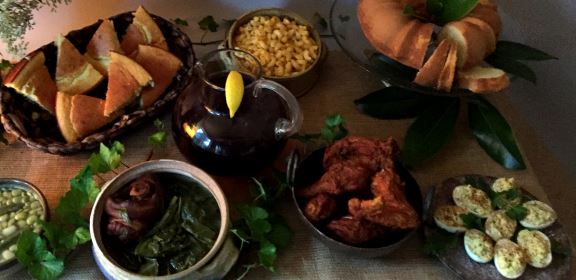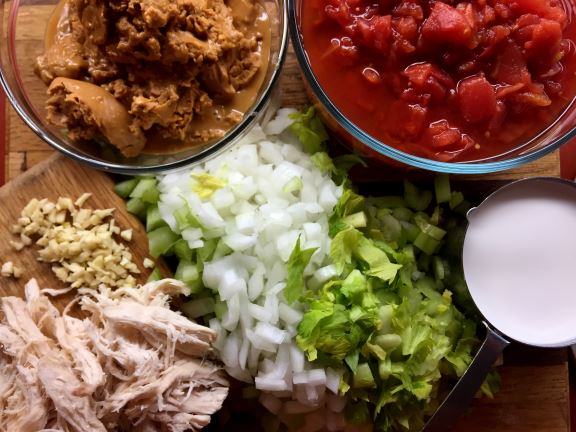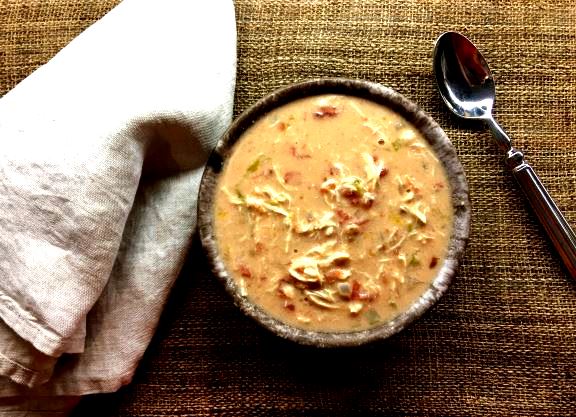The Southern Spread

This month’s feature:
Peanut Soup
George Washington Carver put peanuts on the map by inventing over a hundred recipes and uses for them, largely at Tuskegee University in Alabama. We had a president from Georgia, who was a peanut farmer, further raising the awareness of the legume. (No, they’re not actually a nut.) The crop is grown only in southern and a few southwestern states, and we southerners take pride in our somewhat intimate relationship with peanuts. Some of us—“of a certain age”—remember putting them in a bottle of “Coca-Cola” when we were kids, and we can’t wait for the early fall to enjoy them boiled. But, and I’d have lost this bet, peanuts didn’t originate in the South.
Like so many of our foods, peanuts were introduced to the country by slaves. The peanut plant has its origin in Argentina, was taken to Africa by the Portuguese, and it made its way onto our shores via the slave trade.
George Washington Carver, born into slavery, turned the peanut into a cash crop that helped save the South’s farming economy, but he didn’t invent peanut butter, as is widely believed. The Aztecs get credit for that. He did, however, turn peanuts and the vines and shells into everything from cooking oil to shampoo, to hand and face lotion, and even linoleum and wallboard—the list is lengthy. He was an accomplished cook who created the peanut cookie and peanut brittle, and although he didn’t actually invent peanut soup, he did develop a simple recipe for it, which included milk, butter, flour, ground peanuts, and salt and pepper.
Peanut soup is, without question, an African dish, and would have had, in addition to ground peanuts, any number of other ingredients, including chicken, tomatoes, yams, onions, garlic, chili peppers, and a choice of vegetables including okra, squash, eggplant, beans and corn. The soup is a staple of African cuisine.
Peanut soup is a little like gumbo—as unique as each cook. Some use tomatoes, some don’t; some use lamb, and some use chicken; some don’t add meat at all. Below is a recipe that is a Virginia specialty that would be an example of one that doesn’t include meat:
Virginia Peanut Soup
3 Tablespoons Butter
1 Small Vidalia Onion, Chopped
1 Stalk Celery, Finely Chopped
1 Carrot, Finely Chopped
2 Cloves Garlic, Minced
2 Tablespoons Flour
3-4 Cups Hot Chicken Stock Or Broth
1/2 Cup Heavy Cream
1 Cup Natural Peanut Butter (No Sugar Added)
Juice Of 1/2 – 1 Lime (To Taste)
Melt butter in a saucepan, add onions, celery, and carrots and cook until onions become translucent. Add garlic and cook for an additional 2 minutes. Whisk flour into the onion mixture, cook for 1 minute, then whisk in the hot chicken stock. While stirring, cook 5 minutes until moderately thickened. Next, whisk in the heavy cream and peanut butter, heat the soup through, but do not bring to a boil. Stir in the lime juice. Serve with optional toppings such as chopped toasted peanuts, scallions, cilantro, cayenne, or hot sauce.
I have loved peanut soup since I first tasted it at the Brushmark Restaurant in the Memphis Brooks Museum. The restaurant hasn’t been in operation in some time, but the memory of that soup has stuck with me. I’ve developed a recipe that was influenced by an African cookbook and my memory of that Brushmark soup. The recipe follows:
My Version of Peanut Soup

Ingredients for cooked chicken and broth
Two Chicken Breasts
One stalk celery
One carrot
One small onion
Chopped parsley
One teaspoon leaf thyme
Two crushed bay leaves
12 peppercorns
Salt to taste
Cover chicken with water and add remaining ingredients. Bring to a boil and then simmer until the chicken is tender. Remove and shred the chicken and then strain the other ingredients, leaving the broth.
Soup Ingredients
Three stalks celery (chopped)
One medium onion (chopped)
Two cloves garlic (chopped)
Two cooked chicken breasts (shredded)
One can petite diced tomatoes
Eight cups (approximately) chicken broth
One and one half cup natural crunchy peanut butter (no sugar)
Two cups half ‘n half
Juice of a quarter lemon
Butter
Olive oil
Dash of Tobasco
One fourth teaspoon cayenne pepper
Chopped green onions for garnish
Gently sauté the onions and celery in butter and olive oil,
adding the garlic at the end
(The vegetables are best still crisp)
Add all the other ingredients and simmer until all of the peanut butter has melted.
(Again, the vegetables are best if still crisp, so don’t overcook)

http://porchscene.com/2016/10/03/sometimes-you-feel-like-a-nut-sometimes-not/
Our culture, our history, our spirit, and our hospitality are some of the ingredients. Southern foods are heavily influenced by African, English, Scottish, Irish, French, and Native-American cuisine, and although most of them are served across the country today, there are foods in the U.S. that are strictly thought of as SOUTHERN. There’s Creole, Lowcountry and Floribbean, and I’m not sure where fried chicken and deviled eggs fit into the mix, but to be certain, they perform with a southern accent. In “The Southern Spread,” we’re exploring southern foods and traditions.
Photos: Deborah Fagan Carpenter


